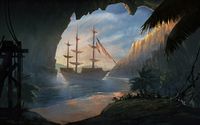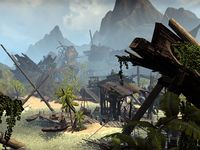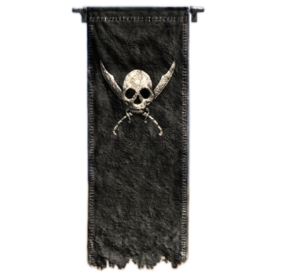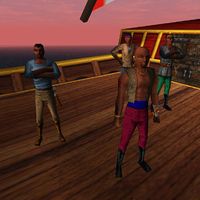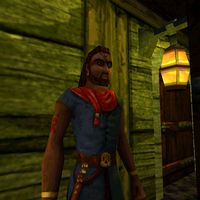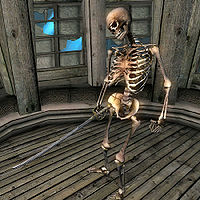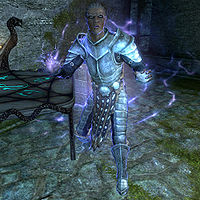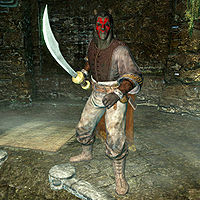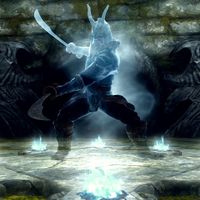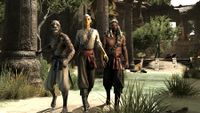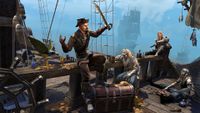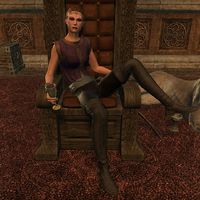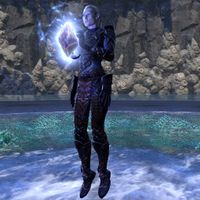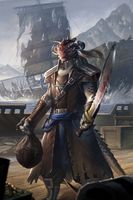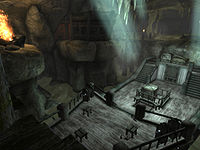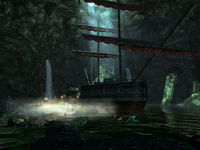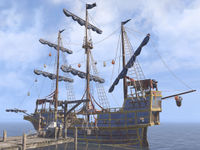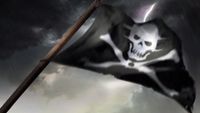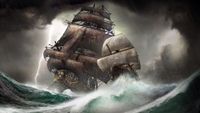Lore:Piracy
Piracy is the illegal practice of attacking and robbing ships at sea. Throughout the history of Tamriel, many pirates have plagued the seas. Some have been called to piracy by the thrill of adventure,[1] while others seek power.[2] Still others might seek glory,[3] wealth,[4] or infamy and renown.[5]
Pirates around the World[edit]
The combined regions of the Iliac Bay, the Bjoulsae, and the Yrinthi Rivers are notoriously infested with pirates.[6] The Kingdom of Wayrest has had to deal with it the most for all of its history, from before the kingdom was founded to the Fourth Era when its capital was sacked.[7][8] Near its waters, where the Iliac Bay meets the Bjoulsae River, are a series of small islands used by raiders and smugglers as protected harbors. The most infamous of them was Blackheart Haven.[9] Up until the fifth century of the Third Era, the Isle of Balfiera was the pirates' main haven. This was before the island was declared haunted and its ruler, Medora Direnni was kept in her tower.[10]
The city of Senchal is the largest port in southern Tamriel, as well as the favored spot for pirates, smugglers, and sea captains who want to partake in illegal trade and the black market.[11] For a brief time after the Knahaten Flu, pirates and other criminal organizations ran the city, bringing the Kingdom of Pellitine to a dark age. That was until the Thirteenth Legion intervened and brought order to Senchal.[12]
Pirates plague the Lower Niben and the Topal Bay since Red Bramman's time, and they were especially prevalent during the Interregnum when the Empires of Cyrodiil were at their lowest. As former Chief Councilor of the Elder Council, Tarnian Lovidicus puts it, "If trade is the lifeblood of the Empire, then the pirates of Topal Bay are vampires of the worst sort—reckless and insatiable fiends who care not whether they destroy the very thing they feed upon."[13] Pirates on the Southern Sea are not as feared as their Abecean Sea counterparts, because they keep a much lower profile, trying to evade Altmer and Maormer ships. These pirates are made up of all races in Tamriel, but they mostly comprise of Khajiit.[14]
To bypass Leyawiin's low stone bridge, pirates disguise themselves as common merchants and bribe officials to let them through. These pirates have invaded homesteads as far north as Bravil and the Corbolo River.[13]
History[edit]
There have been many acts of piracy throughout the eras. The following are just a few notable events involving pirates.
First Era[edit]
The Akaviri first appeared in Tamrielic history as pirates. Many accounts at that time describe strange beastfolk manning these ships. Some references discovered by present-day scholars suggest pirates with rat-like or canine features. The Imperial Geographic Society believe these could have been scouts for their eventual invasions.[15] Akaviri pirates were also known to roam the Iliac Bay[7] and the Hammerfell coast.[16]
When the Rourken Clan disappeared in 1E 700, they left their cities abandoned and rife with unguarded treasures. Many kinds of pirates, from the Abecean, Nordic, and Akaviri looted these ruins for everything they had to offer.[16][17]
During the reign of Empress Hestra in the 11th century of the First Era, the Argonian brigand Red Bramman terrorized Black Marsh, particularly the coastline along the east of Topal Bay. The Empress demanded the head of the pirate-king, and began an aggressive anti-pirate campaign. After many unsuccessful battles in the Bay, the Imperials finally managed to discover the escape route of Red Bramman. Following the pirate deep into the swamplands, they attacked his bandit kingdom and slew him. This not only ended the pirate menace, but exposed the Empire to true Argonian culture.[18]
Second Era[edit]
During the first three centuries of the Second Era, Fort Grief was occasionally used as a watchtower by Imperial customs officials and nearby cities to combat smuggling and local piracy in Niben Bay.[19]
In the year 2E 577, Fortunata ap Dugal, a high-ranking shipping magnate in the Gold Coast Trading Company known as the Pirate Queen, used her fleet of Red Sail pirates and merchant marines to take over Anvil and name herself Provincial Governor. She declared the Gold Coast to be an independent state, and began ruling the state with an iron fist. She banned military vessels from her ports and made her city into a safe haven for pirates, but also attracted merchant vessels by offering promising markets. By using her pirates as a private army and extorting the populace with "taxes", Fortunata quickly grew into a powerful but cruel dictator.[2] However, despite her power, Fortunata's ambition proved to be her undoing. Her efforts entwined herself in a three-way power struggle with Count Carolus Aquilarios of Kvatch and Primate Artorius of the Akatosh Chantry. By 2E 582, she was made the target of the Dark Brotherhood upon the request of Count Carolus and assassinated.[20]
Also in the year 2E 582, a group of Maormer pirates known as the Dreadsails began to terrorize the waters surrounding High Isle and Amenos. The fleet under Fleet Queen Taleria was using storm magic from Dreadsail Reef to devastate the area. After gathering lodestones, Taleria and the Dreadsails planned to use their magic and fleet to conquer the entirety of the Systres. However, the Dufort flotilla under Admiral Galvendier managed to defeat the pirates with the help of the Vestige.[21] A surviving branch of the Dreadsails under Sealord Nalos attempted to invade Galen and build an island-kingdom, though this invasion was stopped by the Vestige and Captain Siravaen.[22]
The Restless League was a group of Redguard pirates based out of a hidden cove near Stros M'Kai. The League played a critical role in the uprising there during 2E 864. Their leader was a man named Basil; other prominent members included Iszara and later her brother Cyrus.[23] The League used the lighthouse in Saintsport as a signal for members to receive transport to their hideout.[24]
Third Era[edit]
In the third century of the Third Era, during the time of the Camoran Usurper, the famous pirate Torradan ap Dugal rose to power. He killed his predecessor in a mutiny, and became captain of the Black Flag, the fastest ship in the sea. He amassed a fleet that he called the Red Sabre, and began terrorizing the Gold Coast by preying on unescorted suppy ships. He became known as the "Scourge of the Abecean Sea, Terror of the Gold Coast, Cutthroat of Hunding Bay, and Lord Captain of the Red Sabre", and was untouchable in his Anvil base despite a bounty of forty thousand coins. After the defeat of the Usurper, however, the Empire was able to better focus on the pirate threat. Commodore Fasil Umbranox managed to track down Captain Dugal and set a trap. After a battle in Anvil Bay, the Red Sabre fleet was defeated and Umbranox's mages caused a cliff wall to collapse on top of the Black Flag. The collapse created Dunbarrow Cove, trapping the crew underground for decades until they each slowly died.[25] The crew became skeletons and haunted the cavern for many years. When the cavern was uncovered in 3E 433 under Castle Anvil, the Hero of Kvatch put the spirits of Dugal and his crewmates to rest and claimed ownership of the cave.[26]
Piracy was very active around Betony prior to the Warp in the West.[UOL 1] In 3E 429, the Butcher of the Bay was a pirate who had been terrorizing the Inner Sea for many months, murdering everyone in his path and decorating his ship with their bodies.[UOL 2] Also in the year 3E 433, the captain of the Marie Elena was assassinated by the Dark Brotherhood,[27] and the crew of The Sea Tub Clarabella was stopped from smuggling sheep by the Hero of Kvatch.[28]
Fourth Era[edit]
In 4E 188, the city of Wayrest was sieged by corsairs. Fearing for his life and knowing about a conspiracy against him, the king made a deal with the pirates and left the city gates open for them, so they could come in and destroy the conspirators who plotted to assassinate him. Despite one assassin fearing the city was lost,[8] the Forgotten Hero aided the city defenders in driving off the corsairs from the city gates.[29][30]
In 4E 201, the Stormcloak Rebellion erupted across Skyrim. A group of pirates known as the Blood Horkers exploited the conflict to raid the northern coastline in the Sea of Ghosts. The wealthy Clan Shatter-Shield made a deal with the pirates to hold a monopoly on trade while competitors were left to deal with attacks. Eventually, the Blood Horkers began attacking the ships of the East Empire Company. Unfortunately for the pirates, the company retaliated, attacking the island fortress of the Blood Horkers, Japhet's Folly. The leader of the pirates, the battlemage Haldyn, was killed in the attack and the group was decimated.[31]
Other[edit]
In ancient Skyrim, the infamous pirate king Haknir Death-Brand terrorized the northern coasts of Tamriel. He had a horrific scar on his face, the eponymous Deathbrand rumored to be from a deal with Mehrunes Dagon. He was said to have an extended life from feeding on the blood and souls of those he killed. His own crew knew him for his madness and fits of rage, and how he delighted in death and destruction. But the King of Ghosts was most known, and feared, for his armor of gleaming Stalhrim and his twin swords that could scythe men like grass. When Haknir Death-Brand was nearing his death, he found that none of his crew was worthy of succeeding him as captain. He cursed his treasure and ship in the name of Dagon, and declared that no one would possess his treasure unless they defeated him in battle. Haknir was finally buried in Gyldenhul Barrow.[4] However, his death was not the end of his tale. His spirit continued to defend his treasure until the year 201 of the Fourth Era. Finally, he was defeated by the Last Dragonborn, who claimed his treasure and gear.[32]
The pirate Velehk Sain is a Dremora known as the "Pirate King of the Abecean", and was feared for scouring the Abecean Sea. His ship's sails are said to portend madness and fear, and blood on the water signals his advance. He would attack Elven and Imperial ship alike, slaughtering and plundering all he could find.[5] He amassed a fortune in treasure, and could hide it with magic. In 4E 201, he was summoned by a member of the College of Winterhold to answer for the deaths of students. It is unknown if he was banished back to Oblivion or if he shared some of his wealth in exchange for his release.[33]
There is a (likely fictitious) saga of a pirate captain named Captain Wereshark and his crew. The surviving remnants of this saga involve a few exploits ranging from Skyrim to Pyandonea. He and his crew were said to have rescued painted cannibals from the Isle of Red Mists and plundered the draugr-infested tomb of Prince Vaugr. When trapped at sea due to a lack of any wind, Captain Wereshark and Crackteeth the Cannibal Priestess retired to Wereshark's private quarters to perform a ritual. Because of Wereshark's prowess, a pair of giant sea turtles aided the crew in getting to shore. During a raid of Pyandonea, Captain Wereshark and his crew defeated a Sea Serpent at the cost of a war galleon, and hunted Lizard Bulls. After surviving an army of Sea Elves with the unintended aid of a horde of enraged Lizard Bulls, the crew raided an unprotected island with Maormer architecture and a lot of treasure.[34]
Gallery[edit]
See Also[edit]
- For game-specific information, see the Redguard, Morrowind, Bloodmoon, Oblivion, SkyrimDB, and Elder Scrolls Online articles.
Books[edit]
- Pirate King of the Abecean — An ode to the Pirate King
- Pirate Queen of the Gold Coast by Midara Salviticus, Historian, University of Gwylim — A treatise on Governor Fortunata ap Dugal
- Deathbrand — The tale of a legendary pirate and his treasure
- The Saga of Captain Wereshark — Various adventures of Captain Wereshark and his crew
- Cap'n Dugal's Journal by Torradan ap Dugal — The last words of Captain Torradan ap Dugal, Scourge of the Abecean Sea
References[edit]
- ^ Annyce Favraud's Dialogue in ESO
- ^ a b Pirate Queen of the Gold Coast — Midara Salviticus, Historian, University of Gwylim
- ^ Events of The Face of Change in ESO
- ^ a b Deathbrand
- ^ a b Pirate King of the Abecean
- ^ Daggerfall User's Guide/History
- ^ a b Wayrest, Jewel of the Bay — Sathyr Longleat
- ^ a b Cicero's Journal — Cicero
- ^ Blackheart Haven loading screen text in ESO
- ^ The Daggerfall Chronicles/Narrative
- ^ Pocket Guide to the Empire, 1st Edition: The Elsweyr Confederacy — Imperial Geographical Society, 2E 864
- ^ The Shields of Senchal — Ziri, Chronicler of the Senchal City Council
- ^ a b Pirates of Topal Bay — Tarnian Lovidicus, Chief Councilor
- ^ Cave of Broken Sails loading screen text in ESO
- ^ Pocket Guide to the Empire, 3rd Edition: Other Lands — Imperial Geographical Society, 3E 432
- ^ a b Pocket Guide to the Empire, 3rd Edition: The Ra Gada: Hammerfell — Imperial Geographical Society, 3E 432
- ^ The Improved Emperor's Guide to Tamriel: Hammerfell — Flaccus Terentius, 2E 581
- ^ Pocket Guide to the Empire, 3rd Edition: The War with the Trees: Argonia and the Black Marsh — Imperial Geographical Society, 3E 432
- ^ The Restoration of Fort Grief — Devastator Idrian Volturno, Spring, 2E 580
- ^ Events of A Special Request in ESO
- ^ Events of Reavers of the Reef in ESO
- ^ Events of Tides of Ruin in ESO
- ^ Events of Redguard
- ^ Contact the League quest in Redguard
- ^ Cap'n Dugal's Journal — Torradan ap Dugal
- ^ Events of Thieves Den
- ^ Events of A Watery Grave in Oblivion
- ^ Events of Illegal Cargo in Oblivion
- ^ Events of City Gates (quest) in Legends
- ^ Events of Castle Wayrest, Throne Room in Legends
- ^ Events of Rise in the East in Skyrim
- ^ Events of Deathbrand in Skyrim
- ^ Events of Forgotten Names in Skyrim
- ^ The Saga of Captain Wereshark
Note: The following references are considered to be unofficial sources. They are included to round off this article and may not be authoritative or conclusive.
- ^ Bourn in Wood — Lord Woodborne
- ^ Ted Peterson's posts in Playing Houses
